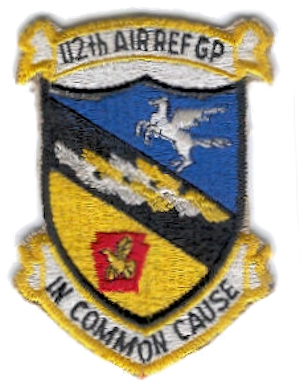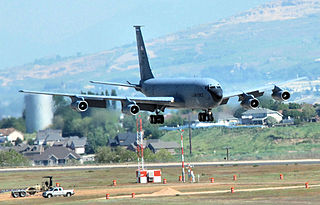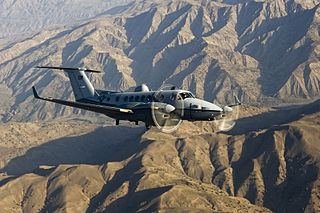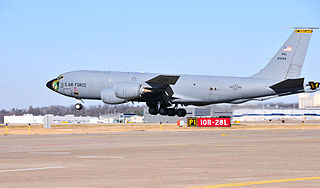
The 108th Wing is a unit of the New Jersey Air National Guard, one of the many units stationed at the McGuire Air Force Base entity of Joint Base McGuire-Dix-Lakehurst, New Jersey. If activated to federal service, the Wing is gained by the United States Air Force Air Mobility Command.

The Pennsylvania Air National Guard (PA ANG) is the aerial militia of the Commonwealth of Pennsylvania, United States of America. It is, along with the Pennsylvania Army National Guard, an element of the Pennsylvania National Guard.

The 112th Air Refueling Group is an inactive unit of the Pennsylvania Air National Guard, stationed at Pittsburgh IAP Air Reserve Station, Pennsylvania. It was inactivated on 1 October 1993.

The 121st Air Refueling Wing is a unit of the Ohio Air National Guard, stationed at Rickenbacker Air National Guard Base, Columbus, Ohio. If activated to federal service, the Wing is gained by the United States Air Force Air Mobility Command.

The 151st Air Refueling Wing is a unit of the Utah Air National Guard, stationed at Roland R. Wright Air National Guard Base, Utah. If activated to federal service, the Wing is gained by the United States Air Force Air Mobility Command.

The 136th Airlift Wing is a unit of the Texas Air National Guard, stationed at Naval Air Station Joint Reserve Base Fort Worth, Fort Worth, Texas. If activated to federal service, the wing is gained by the United States Air Force's Air Mobility Command (AMC).

The 134th Air Refueling Wing is a unit of the Tennessee Air National Guard, stationed at McGhee Tyson Air National Guard Base, Knoxville, Tennessee. If activated for federal service, the Wing is gained by the United States Air Force Air Mobility Command. The 134th Air Refueling Wing's KC-135 mission is to provide air refueling and airlift, as directed by the Secretary of Defense. It has been stationed at McGhee Tyson Airport since December 1957, though the ANG facility at the airport has been redesignated several times. Their radio callsign is "Soda"

The 128th Air Refueling Wing is a unit of the Wisconsin Air National Guard, stationed at General Mitchell Air National Guard Base, Milwaukee, Wisconsin. If activated to federal service in the United States Air Force, the wing is operationally gained by the Air Mobility Command (AMC).

The 137th Special Operations Wing is a unit of the Oklahoma Air National Guard located at Will Rogers Air National Guard Base, Oklahoma. If activated to federal service, the wing is gained by Air Force Special Operations Command. During World War II, its predecessor, the 404th Fighter Group, flying Republic P-47 Thunderbolts, provided close air support to troops following the Operation Overlord, the Normandy landing until the close of the war. The wing is entitled to the honors won by the group by temporary bestowal.

The 171st Air Refueling Wing is a unit of the Pennsylvania Air National Guard, located at Pittsburgh International Airport in Coraopolis, Pennsylvania. If activated to federal service, the Wing is gained by the United States Air Force Air Mobility Command.

The 127th Air Refueling Group is a unit of the Michigan Air National Guard, assigned to the 127th Wing, Selfridge Air National Guard Base, Michigan.

The 171st Air Refueling Squadron is a unit of the Michigan Air National Guard's 127th Wing located at Selfridge Air National Guard Base, Michigan. The 171st is equipped with the KC-135T Stratotanker.

The 132nd Air Refueling Squadron is a unit of the Maine Air National Guard 101st Air Refueling Wing located at Bangor Air National Guard Base, Bangor, Maine. It is equipped with the KC-135R Stratotanker.

The 147th Air Refueling Squadron is a unit of the Pennsylvania Air National Guard 171st Air Refueling Wing located at Pittsburgh IAP Air Reserve Station, Pennsylvania. The 147th is equipped with the KC-135T Stratotanker.

The 166th Air Refueling Squadron is a unit of the Ohio Air National Guard 121st Air Refueling Wing located at Rickenbacker Air National Guard Base, Columbus, Ohio. The 166th is equipped with the KC-135R Stratotanker.

The 196th Attack Squadron is a unit of the 163d Attack Wing of the California Air National Guard stationed at March Joint Air Reserve Base, California, operating the MQ-9 Reaper remotely piloted aircraft.

The 465th Air Refueling Squadron is a United States Air Force Reserve squadron, assigned to the 507th Operations Group, 507th Air Refueling Wing, stationed at Tinker Air Force Base, Oklahoma. The squadron operates the KC-135R aircraft conducting aerial refueling missions.

The 163rd Attack Wing is a unit of the California Air National Guard, stationed at March Air Reserve Base in Riverside, California. If it were activated into federal service, elements of the 163 ATKW would be gained by the United States Air Force's Air Combat Command (ACC) and Air Education and Training Command (AETC).

Pittsburgh IAP Air Reserve Station is a United States Air Force base, located at Pittsburgh International Airport, Pennsylvania. It is located 12.1 miles (19.5 km) west-northwest of Pittsburgh, Pennsylvania.

The 127th Wing is a composite wing of the United States Air Force and Michigan National Guard. It comprises approximately 1,700 citizen airmen and provides highly trained personnel, aircraft, and support resources to serve the Michigan community, the state and the United States. The Wing operates Boeing KC-135 Stratotankers, providing global aerial refuelling capability supporting Air Mobility Command and the Fairchild Republic A-10 Thunderbolt II, flying the close air support mission for Air Combat Command. The current commander of the 127th Wing is Brig. Gen. Matthew G. Brancato. With approximately 1,700 personnel assigned, the 127th Wing is among the most complex Air National Guard wings. The 127th Wing's home station, Selfridge Air National Guard Base, is the largest facility managed by a reserve component of the U.S. Air Force.



























